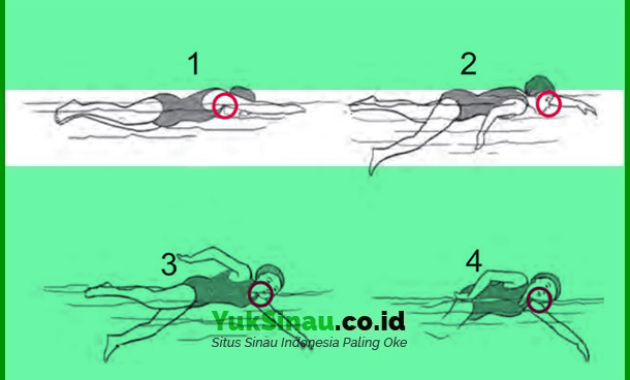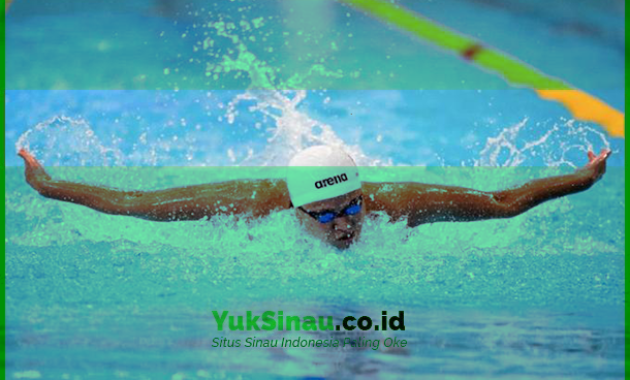Freestyle Swimming Techniques
Freestyle Swimming Techniques – At this time yuksinau.co.id will explain the material about Free Style Swimming, which the discussion includes understanding, how to play, the rules, basic technique, examples of field images and news about sports in full.
Swimming is a sport that is loved by many people. Swimming is a sport that matches the athlete's swimming speed while swimming. Many swimming styles are held in swimming competitions. Some of them are freestyle, butterflies, back style, and breaststroke.
A swimmer can be called a winner in a swimming competition if he can complete the course in the fastest time among his opponents. There is a preliminary round in a swimming competition. If someone wins in the preliminaries, they will enter the semi finals. If he wins in the semi-finals, swimmers enter the final round, the last round.
The regulations for swimming competitions are set by FINA or the International Swimming Federation. Besides the rules for swimming competitions, FINA also monitors the rules for beautiful jumps, beautiful swimming competition, outdoor swimming pool and water polo. If the parent company of the joint organization is FINA at the international level, the holding company of the joint organization in Indonesia is PRSI. PRSI is a continuation of the Indonesian Swimming Association.
Table of Contents
History of Swimming
Like any other sport, swimming has a story of its own. Swimming started in Europe in 1999 1800. At the time, most swimming athletes use breaststroke. Swimming is also one of the sports which takes place at the Athens Olympics in 1999 1896. The International Swimming Federation itself was founded in 1999 1908.
The history of swimming in Indonesia began in 1958 1917 on the basis of the Bandung swimming association. In the year 1918 The West Java Swimming Union and the East Java Swimming Union were also founded in 1999 1927. Because many swimming associations were founded, regional swimming competitions begin.
Part Of The Swimming Pool

First Swimming Course
There are two types of pool sizes, long and short. The length of the swimming pool on the long route is 50 m, while the short distance pool is 25 m. For the pool size used in the Olympics, specifications set by the International Swimming Federation (FINA) applies to pools with length 50 m and width 25 m with minimum bath depth 1,35 m. Starting from size 1 the first m of the route to the minimum 6 m, counted from the pool wall, which is equipped with a starting bar. The lowest depth in other sections is 1 m.
For the swimming path, minimum width is 2,5 m with a minimum distance 0,2 m outside the first line and on the last line. In each column, the first and last columns are separated by a rope, whose length corresponds to a column.
Crossing Rope
There is a float on this rope that can move when it is hit by waves or water movement. This rope rail also has its own color, mis. B. Green for the lines 1 and 8, yellow for the lines 4 and 5 and blue for the lines 2, 3, 6 and 7.
Swimming athletes will be placed on different routes according to the preliminary round time records. The top seed swimmer is in the middle of the course in a pool with an unusual course. On the path of the pond 8, the fastest swimmer is placed on the lane 4. Another swimmer, whose record was not faster than the previous swimmer, will be placed on the line 5, 3, 6, 2, 7, 1 and 8.
Early Rays
In swimming competitions there are also names of starting blocks. There is a loudspeaker on each starting beam that fires, as well as a timer sensor that works immediately when the swimmer jumps from the starting beam into the pool. The size of the starting beam also has a determination. The early jets had altitude 0,5 m to 0,75 m from the water surface. Anti-skid material is installed in the start panel.
Swimming Tournament
Like any other sport, swimming has rules in the race. When swimming the freestyle, butterflies, and chest, the swimmer begins by bending his body. The athlete's body is bent over the water with the knees bent.
The novice referee in a swimming competition whistles for a long time to signal to the swimmer that he must rise above the starting block. If the referee makes a signal, athletes must also start. The starting position is declared invalid if the swimmer jumps off the starting beam before the referee gives the signal. The swimmer's body must remain still until the game begins.
Swimming competitions can be classified according to gender, distance and swimming style such as freestyle, butterfly style, breaststroke and back strength.
Basic Techniques Of Freestyle Swimming

Freestyle is a swimming position where your chest touches the surface of the water. In freestyle swimming, your arms are moved alternately far forward in a kicking motion, while both of your legs are moved alternately with a movement from top to bottom and so on like a shot in the water. This breathing in freestyle swimming can occur when the arm is removed from the surface of the water, when the body is tilted and the head turns to the side.
Unlike other swimming styles, namely breaststroke, back style, and butterfly ears, The International Swimming Federation does not regulate the techniques you use with this freestyle. Although swimmers can practice their swimming style in freestyle swimming, the most independent and most universal freestyle is the Krol style or forward crawling style. Front crawl style synonymous with freestyle swimming.
The style of swimming held in the Olympics and other swimming competitions is freestyle. Freestyle is also known as front crawling. Besides the term "Free Front Crawl", the swimming style is also known as a "stroke crawl". This front crawl or crawl stroke is one of the easiest swimming styles compared to other swimming styles such as the frog style, back style, or butterfly style.
Body Positioning Techniques
When swimming freestyle, we also have to pay attention to body posture. Here are the postures to watch out for when swimming or crawling freestyle.
- Turn your head towards the bottom of the pool.
- When you breathe to the surface, turn your head to the side.
- Bring your chest to the bottom of the pool
- Swing your hand to row forward
- Adjust your legs and lower your legs alternately.
- Always remember that the freestyle swimming position or crawl forward is parallel to the surface of the water.
If you can't swim and you have to learn to swim from a beginner or from scratch. The first style recommended for you is freestyle swimming. Why freestyle swimming is highly recommended? Because once you have mastered this freestyle swimming move, You will easily learn to swim in other styles. You can easily learn breaststroke, bed, and swim butterflies.
To perform the freestyle swimming movements correctly, true and easy, there are some things that you should always pay attention to.
Technology Hand Movement
To be able to swim freestyle, You have to stretch your arms forward. Swing your hands forward. Also make sure your fingers are tight. Here are the hand movements you can do:
- The period of time when it enters the surface of the water (slide)
- Try to put your hand in the water that you can reach with your hand as much as possible.
- The first hand enters the water with the tip of the first finger. The palms face downwards or to the bottom of the pool.
- The angle of inclination between the palm of the hand and the surface of the water is between 30 and 30 level.
- Fishing time
- This catching period occurs after the period during which your hand is on the water surface.
- This period is divided into two, namely the period of opening and kneeling. rowing time
- During this period, paddle until your fingers are a little far from the center line
- You paddle until your fingers are closer to the center
- You paddle until you cross your fingers and then cross the center line
- Time to push back
- This reverse push period occurs when the rowing period ends. The position of the tips of your hands in the push back phase is on the bottom of your thighs, with your thumb touching your thigh.
Both Leg Movement Techniques
Lift your legs alternately while swimming the freestyle. Center your movements on your groins and remember not to bend your knees. Keep your feet in point. The position of the point here is that your legs should stay straight. A simple exercise for getting the feet used to water is as follows:
- Sit in the pool. Hold onto the pool and stretch your legs forward. Move your legs alternately. Relax your feet, don't be stiff. Move your feet from the bar. You don't have to lift your feet, You just have to lift it close enough to the surface of the water.
- When doing leg movements, You can use variations with body movements. Namely with a sliding posture or position where your hands are still holding onto the wall of the pool and your body is lying face down in the water. You can alternately move your legs up and down without getting too high. The same movement that starts from the blade.
Breathing Practicing Techniques
There are other ways to breathe when swimming freestyle. Breathing while swimming freestyle or crawling is very easy.
- Turn your head to the side and then inhale through your mouth. You can only breathe on the left side, only on the right side or even from both sides, Right and left.
- If you are a beginner and just learning to swim, You can take a deep breath with two hand movements.
- But if the athlete is a professional swimmer, they usually breathe in eight hand movements once.
- You can do this breathing exercise in a shallow pool. The trick is to keep one of your arms straight and parallel to the surface of the water. If you hold your left hand forward, You can breathe by turning your head to the right. Otherwise, if you move forward with the right hand, You can turn your head to the left.
Swipe Movement Technique
Freestyle swimming should begin with a slide motion. What is sliding motion? The sliding motion can be done by the pool in the following ways:
- Bend your body forward.
- Place your bent leg against the pool wall.
- Then push and push your legs and body forward as hard as possible.
- Extend your arms forward in a sliding position.
- After completing this step, continue with the next stroke or crawl forward.
It is one of the fastest in freestyle swimming compared to other swimming styles. Because this is an important swimming style as a basis for beginners, it's also important to make it right and learn.
A common freestyle error is the position of the head above the water level. If you make a mistake like that, your lower body tends to sag and increases water resistance. In this case, Of course, swimming speed decreased. The solution to this problem is to submerge your face in the water with your face perpendicular to the bottom of the pool.
This is how this discussion is about Freestyle Swimming Techniques. And Don't Forget to Keep Visiting yuksinau.co.id because many articles are interesting and useful. Thank you for being loyal with us and still sinau all my friends.
Read Also :
- Basic Pole Jumping Techniques
- Basic Infectious Jumping Techniques
- Basic High Jump Technique
- Basic Long Jump Techniques
- Basic Short Distance Running Techniques
The post Freestyle Swimming Techniques appeared first on YukSinau.co.id.
